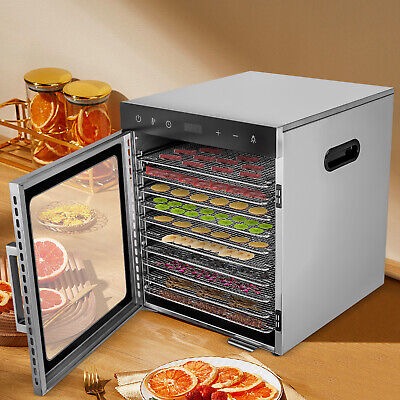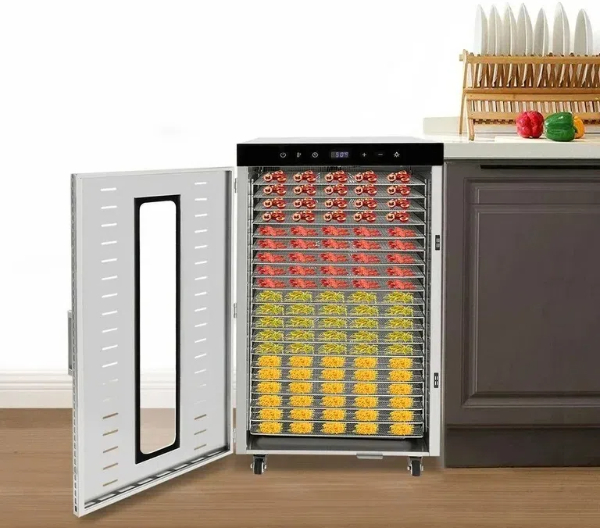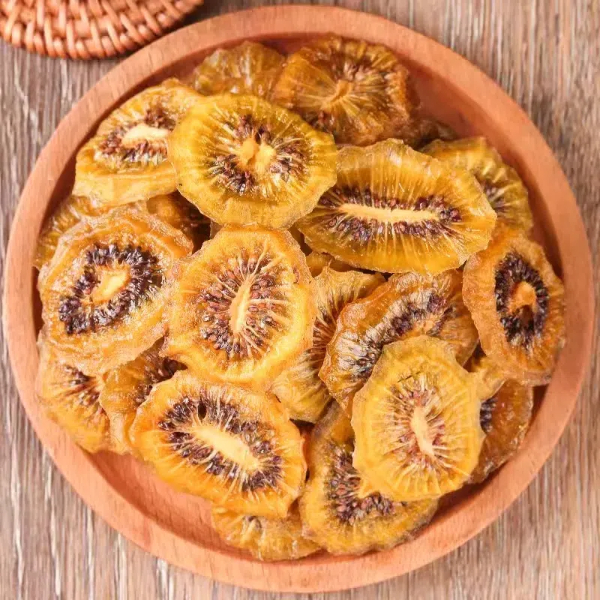
Content Menu
● Introduction
● What is a Cabinet Type Dehydrator?
>> Key Features:
>> Types of Dehydrators:
● Advantages of Cabinet Type Dehydrators
● How to Use a Cabinet Type Dehydrator
>> Preparation
>> Step-by-Step Instructions
>> Temperature and Drying Times
● Best Practices for Effective Dehydration
● Maintenance and Cleaning
● Tips for Maximizing Efficiency
● OEM Services for Food Dehydrators
>> Key Considerations for OEM Partnerships:
● Technical Aspects
>> Components
>> Technical Specifications
>> Patent Information
● Common Mistakes to Avoid
● Advanced Techniques for Dehydration
● Conclusion
● FAQ
>> 1. What is the ideal temperature for dehydrating fruits?
>> 2. How do I clean my cabinet dehydrator?
>> 3. What types of food can I dehydrate in a cabinet dehydrator?
>> 4. How long does it take to dehydrate food?
>> 5. What certifications should I look for when sourcing an OEM food dehydrator?
● Citations:
Introduction
A cabinet type dehydrator is a specialized appliance designed to remove moisture from food, thereby extending its shelf life while preserving its natural qualities. Unlike simpler dehydrators, cabinet models provide a controlled environment that ensures consistent drying, resulting in superior product quality and minimal waste. These dehydrators are particularly useful for fruits, vegetables, meats, herbs, and spices. For Chinese food dehydrator production factories offering OEM services to international brands, wholesalers, and manufacturers, understanding the nuances of cabinet dehydrators is crucial.

What is a Cabinet Type Dehydrator?
A cabinet type dehydrator is a self-contained unit designed to remove moisture from food products. These machines integrate a heat pump dryer with a precisely controlled chamber to optimize performance and maximize energy efficiency.
Key Features:
- High Efficiency: Ensures consistent dehydration while minimizing energy waste.
- Capacity: Suitable for small-to-medium-scale operations, handling batches from 100kg to 1000kg.
- Integrated Design: Optimizes performance and energy utilization.
- Versatility: Can dry a wide range of foods, including fruits, vegetables, meats, herbs, and spices.
Types of Dehydrators:
1. Stackable Dehydrators: These feature vertically stacked trays with the heating element and fan at the bottom or top. They are budget-friendly but may require manual tray rotation for even drying.
2. Cabinet (Box-Type) Dehydrators: Designed for larger-scale operations, offering superior control and consistency. They have a fully enclosed cabinet with trays that slide in and out, ensuring even heat distribution.
Advantages of Cabinet Type Dehydrators
Cabinet type dehydrators offer several benefits, making them a preferred choice for businesses and serious home users:
- Superior Control and Consistency: Ensures uniform drying and high product quality.
- Energy Efficiency: More energy-efficient compared to stackable dehydrators.
- Large-Scale Operations: Suitable for larger-scale operations due to their capacity.
- Controlled Environment: Consistent temperature and air circulation are significant advantages.
- Hygienic Environment: The enclosed design minimizes contamination.
- Nutrient Preservation: Excels at preserving the natural flavors, colors, and nutrients in food.
- Waste Reduction: Helps minimize food waste by converting seasonal harvests into all-season products.
- Extended Shelf Life: Effectively removing moisture significantly increases the shelf life of food products.
- Enhanced Food Safety: The controlled environment helps to prevent the growth of harmful bacteria and mold during the dehydration process.
- Cost Savings: Although the initial investment might be higher, the long-term benefits include lower energy costs and reduced waste.
How to Use a Cabinet Type Dehydrator
Preparation
1. Cleaning: Clean the racks and interior of the cabinet before the first use and after each subsequent use. Use food-grade sanitizers to ensure a hygienic environment.
2. Food Selection: Choose fresh, ripe produce. Overripe or bruised items can affect the final product quality.
3. Food Arrangement: Lay the food in rows on the food tray with at least a 1/4” (6mm) gap between each slice to allow proper air circulation. Avoid overlapping.
Step-by-Step Instructions
1. Preheating: Preheat the dehydrator for 5-10 minutes before loading the racks. This ensures a consistent starting temperature.
2. Powering On: Plug the dehydrator into a suitable power outlet (200-240V/50-60Hz) and press the ‘On/Off' button.
3. Temperature Adjustment:
Press the Temp button.
- Use the increase or decrease button to set the desired temperature.
- Wait until the temperature display stops flashing to confirm.
4. Timer Setting:
- Select the chamber button, then the timer button.
- Use the increase or decrease button to set the dehydration time.
- Wait until the timer display stops flashing to confirm.
5. Loading Racks: Using heat-resistant gloves, load the racks into the dehydrator carefully, ensuring they are correctly placed and the door is latched.
6. Drying: Leave the product to dry, monitoring the progress. Check the moisture content of the food periodically by taking a sample and pressing it. If moisture appears, continue drying.
7. Powering Off: Press the ‘Off' button to turn off the dehydrator.
Temperature and Drying Times
Refer to the dehydrator's manual for specific recommendations. Generally:
- Fruits: Lower temperatures (around 135°F or 57°C) and longer drying times. Fruits like apples, bananas, and berries are ideal.
- Vegetables: Slightly higher temperatures (around 145°F or 63°C). Vegetables like carrots, zucchini, and peppers dry well.
- Meats: Higher temperatures (around 160°F or 71°C) to ensure food safety. Jerky and dried meats can be produced effectively.
- Herbs: Low temperatures (around 95°F or 35°C) to preserve essential oils. Herbs such as basil, oregano, and mint retain their flavors best.
Adjustments should be made based on the thickness and moisture content of the produce. Experimentation and careful monitoring are crucial. Factors such as humidity and altitude can affect drying times, so adjust accordingly.

Best Practices for Effective Dehydration
1. Even Slicing: Ensure food is sliced evenly to promote uniform drying. Use a mandoline or food processor for consistency.
2. Proper Loading: Avoid overcrowding the trays to maintain good air circulation. Leave sufficient space between each piece.
3. Blanching: Blanch certain vegetables to preserve color and nutrients. Blanching involves briefly boiling or steaming vegetables before drying.
4. Pre-treatment: Consider pre-treating fruits with lemon juice to prevent browning and enhance flavor.
5. Rotation: Rotate trays periodically to ensure even drying, especially if your dehydrator doesn't have consistent airflow.
6. Monitoring: Consistently monitor the drying process to prevent over- or under-drying. Check the texture and moisture content regularly.
7. Conditioning: After drying, allow the food to cool completely and then "condition" it by placing it in an airtight container for a week. This helps equalize the moisture content among all the pieces.
8. Fresh Produce: Use fresh produce that is free from blemishes. High-quality ingredients result in better-dried products.
Maintenance and Cleaning
1. Regular Cleaning: Clean the dehydrator after each use to prevent buildup and maintain hygiene. Remove any food particles and wipe down the interior with a damp cloth.
2. Inspection: Regularly inspect the dehydrator for any signs of wear and tear. Check the heating element, fan, and control panel for proper functioning.
3. Tray Maintenance: Clean trays with warm, soapy water. For stubborn residue, soak them in a solution of baking soda and water.
4. Professional Servicing: Schedule professional servicing at regular intervals to ensure optimal performance, including checking the heating element, fan motor, and control panel. This is particularly important for commercial operations.
Tips for Maximizing Efficiency
1. Batch Processing: Operate with full loads to maximize efficiency. This reduces energy consumption per unit of food dried.
2. Strategic Timing: Use the dehydrator during off-peak hours to reduce energy costs. Check with your local utility company for off-peak rates.
3. Temperature Adjustment: Optimize temperature settings for different food types. Avoid using excessively high temperatures, which can lead to uneven drying.
4. Insulation: Place the dehydrator in a well-insulated area to minimize heat loss. Ensure the surrounding environment is not overly humid.
5. Proper Ventilation: Ensure adequate ventilation around the dehydrator to allow for efficient air circulation.
6. Energy Efficiency: To improve energy efficiency, consider batch processing, operating with full loads, using strategic timing during off-peak hours, adjusting temperature settings, and ensuring proper maintenance.
OEM Services for Food Dehydrators
OEM (Original Equipment Manufacturer) services allow businesses to customize and brand their own food dehydrators without needing in-house manufacturing facilities. This approach offers several advantages:
1. Reduced Costs: Eliminates the need for significant capital investment in manufacturing equipment.
2. Quality Control: Ensures products meet international quality standards. Reputable OEM providers have rigorous quality control processes in place.
3. Focus on Marketing and Sales: Allows businesses to concentrate on their core competencies. This can lead to better market penetration and increased sales.
4. Faster Market Entry: Provides a quicker, more cost-effective way to enter the market. This is particularly beneficial for startups and businesses looking to expand their product line.
5. Customization: Allows for tailored designs, features, and branding to meet specific market needs.
Key Considerations for OEM Partnerships:
1. Certifications: Look for certifications such as ISO 9001 to ensure the manufacturer complies with international quality management standards. This is a critical factor in ensuring product quality and consistency.
2. Compliance: Ensure compliance with local regulations in the target market. This includes safety standards, labeling requirements, and environmental regulations.
3. Customization: Ensure the OEM can meet specific design and branding requirements. This includes the ability to customize the appearance, functionality, and packaging of the dehydrator.
4. Capacity: Assess the OEM's production capacity to ensure they can meet your demand. Consider both current capacity and the potential for scaling up as your business grows.
5. Communication: Establish clear and open lines of communication with the OEM. This is essential for ensuring that your requirements are understood and met.
6. Intellectual Property Protection: Ensure that the OEM has measures in place to protect your intellectual property. This includes patents, trademarks, and trade secrets.
7. Material Quality: Verify the quality of materials used in the dehydrator. High-quality materials ensure durability and longevity.
8. Testing Procedures: Understand the testing procedures the OEM employs to ensure product quality and performance.
Technical Aspects
Components
A typical cabinet dehydrator includes several key components:
- Heating Element: Provides the heat necessary for drying. Common types include resistance coils and infrared heaters.
- Fan Motor: Circulates air to ensure even drying. The fan's design and speed are crucial for consistent results.
- Control Panel: Allows users to set temperature and time. Digital control panels offer greater precision and features like timers and automatic shut-off.
- Trays: Hold the food during the dehydration process. Stainless steel trays are durable and easy to clean.
- Insulated Walls and Doors: Minimize heat loss. Good insulation is essential for energy efficiency.
- Air Vents: Regulate airflow to maintain consistent drying conditions.
Technical Specifications
- Power Supply: 200-240V/50-60Hz (adjust to the target market's standard)
- Temperature Range: Typically between 85°F to 165°F (29°C to 74°C). Some models offer extended temperature ranges for specific applications.
- Capacity: 100kg to 1000kg. Capacity should be aligned with the intended use and production volume.
- Material: Stainless steel is commonly used for food-grade dehydrators due to its durability, hygiene, and resistance to corrosion.
- Dimensions: Variable depending on capacity and design. Compact models are available for smaller spaces, while larger models are designed for industrial use.
- Airflow System: Rear-mounted fans typically provide more even airflow than bottom-mounted fans.
- Wattage: Varies depending on the size and features of the dehydrator.
Patent Information
The design and functionality of food processing drying devices are often protected by patents. For example, Chinese Patent CN110207480A describes a food processing drying device and its method of use, including a box body with an insulation layer, a heating component, a cooling device, and a humidity controller. Such innovations aim to improve drying efficiency and reduce energy consumption. Staying informed about relevant patents can help avoid infringement issues and identify opportunities for innovation.
Common Mistakes to Avoid
- Overcrowding Trays: This restricts airflow and leads to uneven drying. Ensure adequate spacing between food pieces.
- Uneven Slicing: Results in some pieces drying faster than others. Use consistent slicing techniques or tools.
- Forgetting to Blanch: Some vegetables require blanching to preserve their quality. Research the specific requirements for each type of food.
- Ignoring Monitoring: Regular checks are essential to prevent over- or under-drying. Use a food thermometer to monitor the internal temperature of the food.
- Using Poor Quality Produce: Always use fresh, high-quality produce. The quality of the starting materials directly affects the final product.
- Improper Storage: Store dried foods in airtight containers in a cool, dark place to prevent moisture absorption and spoilage.
Advanced Techniques for Dehydration
- Fruit Leather: Puree fruits and spread them on dehydrator sheets to create fruit leather, a healthy and delicious snack.
- Vegetable Chips: Thinly slice vegetables and dehydrate them with seasonings for crispy vegetable chips.
- Jerky: Marinate meat slices and dehydrate them to create jerky, a protein-rich snack.
- Powders: Dehydrate herbs, spices, or vegetables and then grind them into powders for use in cooking or seasoning blends.
- Reconstitution: Learn how to properly reconstitute dried foods by soaking them in water or broth to rehydrate them before use.
Conclusion
Cabinet type dehydrators are invaluable for preserving food, reducing waste, and creating healthy snacks. For Chinese food dehydrator production factories offering OEM services, mastering the art and science of cabinet dehydration is essential. By understanding the key features, benefits, and best practices, manufacturers can produce high-quality, efficient dehydrators that meet the demands of international brands, wholesalers, and manufacturers. Proper use, maintenance, and a focus on quality will ensure that these dehydrators provide years of reliable service, helping businesses thrive in the competitive food processing industry. Staying updated with the latest advancements in dehydration technology and techniques will further enhance your ability to deliver superior products and services.

FAQ
1. What is the ideal temperature for dehydrating fruits?
The ideal temperature for dehydrating fruits is around 135°F (57°C). This lower temperature helps to preserve the natural sugars and flavors in the fruit.
2. How do I clean my cabinet dehydrator?
Clean the racks and interior of the cabinet with a damp cloth after each use. For tougher stains, you can use mild detergent or soapy water. Ensure all surfaces are dry before storing the dehydrator.
3. What types of food can I dehydrate in a cabinet dehydrator?
Cabinet dehydrators are versatile and can be used for a wide range of foods, including fruits, vegetables, meats, herbs, flowers, noodles, and pasta.
4. How long does it take to dehydrate food?
Drying times vary depending on the type of food, its thickness, and the dehydrator's temperature. Fruits typically require longer drying times than vegetables. Refer to your dehydrator's manual or a reliable dehydration guide for specific recommendations.
5. What certifications should I look for when sourcing an OEM food dehydrator?
Look for certifications such as ISO 9001, which ensures the manufacturer complies with international quality management standards. Also, ensure they comply with local regulations in your target market.
Citations:
[1] https://www.dryeratech.com/how-to-dehydrate-fruits-and-vegetables-with-a-cabinet-type-dehydrator.html
[2] https://www.aussiestormshop.com.au/assets/files/AU%2016-CUD%20(1).pdf
[3] https://patents.google.com/patent/CN110207480A/zh
[4] https://www.dryeratech.com/best-practices-for-using-your-cabinet-type-dehydrator-effectively.html
[5] https://www.ukjuicers.com/Lib/Doc/Nutridry_ST-10_online_instruction_manual.pdf
[6] https://patents.google.com/patent/CN1110593C/zh
[7] https://soulyrested.com/choosing-dehydrator/
[8] https://www.youtube.com/watch?v=lEUA2t2XD5M











